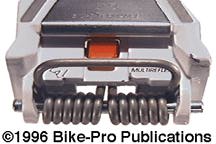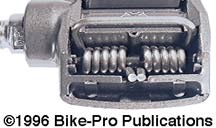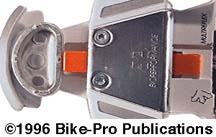Brake Systems
- Brake/Shift Levers
- Caliper Brakes (Road)
- Cantilever Brakes (MTB)
- Brake Levers
- Brake Shifter Combination Levers
- Brake Boosters
- Brake Cables
- Brake Carriers
- Brake Hangers
- Brake Pads
- Titanium Brake Hardware
Computers
Cranks and Chainrings
Forks
Frames & Framesets
Freewheels and Cassettes
Front Derailleurs
Grips
Handlebars
Handlebar Extensions
Headsets
Helmets
Hubs and Skewers
Lubricants
Metal Guide - Bicycle Metallurgy
Mirrors
Pedals and Toe Clips
Pumps and Inflation Systems
Racks
Rear Derailleurs
Rims & Rimstrips
Saddles
Seatposts and Binder Bolts
SRP Replacement Titanium &
Aluminum parts - Master Index
Stems
Tires
Tubes
Shoes
Spokes (Tables Only)
Tools - Bicycle Repair Tools
Yakima Fit List -to fit all cars
Notes
Links
Home
Time Family of Clipless Pedals




Time, of France, is another maker of clipless pedal systems. Time was first to recognize that many cyclists pedal strokes were necessarily being modified by pedals that rigidly locked the riders cleated foot into one position with one type of pedal rotation. The Time pedals adapt to idiosyncrasies unique in each riders knee and ankle joints as well as the overall movement of the leg in a pedal rotation. While your foot is firmly gripped by the cleat in the pedal, the entire cleated shoe is permitted to move horizontally across a 7mm spread. The Time cleat system permits the cleated shoe to swivel in the pedal with up to 5 degrees in lateral rotation, either inward or outward. This solution for the naturally occurring variation in pedal stroke Time calls BioPerformance. Time pedals have no adjustment for spring release tension. All Time pedals are factory preset to one tension, holding the cleat firmly, while permitting release any time the foot reaches 20 degrees from straight ahead. The bearing and spindles used in the Time pedals are the same throughout the line, except for the Titan Magnesium, which is described separately. The spindle is made of forged steel with light machine work then chrome plated. After plating the area in contact with the bearings are ground and polished. The threaded end has a 6mm allen fitting to simplify installation. The outer bearing in each case is a pressed into- the-body needle bearing assembly that supports the outer end of the spindle. Time relies on a sealed bearing cartridge for the inner bearing, made in Japan by NTN (model # 6901LU), that slides down the spindle and is held in place with a cir-clip snapped into a recess on the spindle. A Black plastic seal closes off the entire bearing assembly from the outside. The entire spindle assembly is held in the pedal body by an expanding lockring recessed just in front of the dust seal. Time makes two styles of cleated systems, one type is the TBT or Time BioPosition Technology. The TBT style is used by both professional racers and amateur enthusiasts for sports and racing purposes. The other is the TWT or Time Walking Technology that is used by sport and recreational riders because it has a recessed cleat that permits you to walk in cycling shoes without the discomfort of teetering over a cleat with each step. The TBT type of pedal uses two cast metal cleats that bolt to the bottom of the shoe. The one in the front, called the toe clip, slides into the toe of the pedal with an extended lip. It's held in place by a radiused groove allowing the toe to swivel while not releasing from the pedal. The rear cleat, called the rear cam, has a rounded bottom so that downward pressure pushes back a spring bar. When the bar moves back to a certain point, the cleat fully seats in the pedal and the spring bar pushes the cleat and entire shoe forward so that a lower lip on the front of this rear cam slides into a cast recess just over the spindle. With this system both clip pieces are actively engaged while being clipped in. The release occurs when the rear cam is placed at a 20¡. At that position the depth of the installed rear inner lip is reduced to zero because the rear fastening lip is cast with a 20 degree angle on it's front face. At that 20 degree foot rotation the cleats come free of the pedal in a vertical, horizontal or diagonal pull. A frequently asked question about the TBT system is "What prevents the toe clip from rotating freely out of the front of the pedal effecting an accidental rear release?" When the rear cam is pressed into the pedal, it pushes a pivoting lever down that raises a square plastic stop in the front of the pedal just behind where the front toe clip is seated. This pivoting piece is called the Racing Clip and it rises only when the rear cam is seated in the pedal. It's flat front edge butts to the rear of the front toe clip restricting it's movement, preventing unwanted release up to the 20¡ foot position, where release is a certainty. The BioPosition Principle in TBT comes from how deeply the cleat sits over the spindle. In other cleat systems the cleat rests well above the spindle imbedded in the pedal body. Time pedals are made with a narrow spindle in the cleat area, and the cleats actually drop down over the spindle. The distance from the shoe bottom to the center of the spindle in Time TBT pedals is reduced considerably over other pedal types. This shortened distance benefits the rider by giving better energy transmission to the drive train and increased Biomechanical efficiency. The spring system in the TBT style pedals is made of one piece of coiled spring steel that is wrapped around a rod at the rear of the pedal. The rod is driven into the pedal, through the spring, and into the far side of the pedal. The ends of the spring come together in the center and are held in place under the body of the pedal. It raises and loops from one side to the other, making a strong bar-styled spring at the outer ends of the spring, like the type used in many mouse traps. The Time TWT style cleat uses a single cast brass cleat for each shoe. To engage the cleat, you hook the front lip of it under a steel bar and press down. With downward pressure the rear spring moves back under the rounded edge of the rear cleat until the cleat seats on the pedal surface. When the cleat reaches bottom and contacts the pedal ,the rear spring snaps forward again over the rear lip on the cleat, to hold it firmly in place until rotated to the 20¡ outward angle, when it releases. The front rod is fashioned like a steel D-ring and held in place with a cast aluminum bridge clamp that is bolted from the bottom with a T-15 Torx pan head machine screw. Unsnapping a plastic cover on the rear of the TWT pedal reveals the same style of spring used in the TBT pedals are in use here to hold the cleat. All weights given were digitally weighed from actual production pedals and represent the accurate weights of any pedals you can expect to receive.

